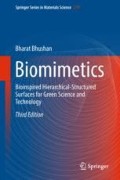Abstract
Unlike the lotus leaf , some rose petals ( rosea Rehd ), scallions, and garlic exhibit superhydrophobicity with high contact angle hysteresis (CAH). While a water droplet can easily roll off the surface of a lotus leaf , it stays pinned to the surface. The different behavior of wetting between the lotus leaf and the rose petal can be explained by different designs in the surface hierarchical micro —and nanostructure . The rose petal’s microstructure , and possibly nanostructure , has a larger pitch value and lower height than the lotus leaf . Therefore, the liquid is allowed to impregnate between the microstructure and partially penetrates into the nanostructure , which increases the wetted surface area. As a result, contact angle hysteresis increases with increasing wetted surface area. In the case of scallion and garlic leaves, contact angle hysteresis is high due to hydrophobic defects responsible for contact line pinning . Such superhydrophobic surfaces with high adhesion have various potential applications, such as the transport of liquid microdroplets over a surface without sliding or rolling, the analysis of very small volumes of liquid samples, and for the inside of an aircraft surface to minimize the falling of condensed water droplets onto passengers. There have been few attempts to fabricate such surfaces in the laboratory.
Access this chapter
Tax calculation will be finalised at checkout
Purchases are for personal use only
References
Bhushan, B. (2013), Introduction to Tribology, second ed., Wiley, New York.
Bhushan, B. and Her, E.K. (2010), “Fabrication of Superhydrophobic Surfaces with High and Low Adhesion Inspired from Rose Petal,” Langmuir 26, 8207–8217.
Bhushan, B. and Jung, Y.C. (2007), “Wetting Study of Patterned Surfaces for Superhydrophobicity,” Ultramicroscopy 107, 1033–1041.
Bhushan, B. and Jung, Y.C. (2011), “Natural and Biomimetic Artificial Surfaces for Superhydrophobicity, Self-Cleaning, Low Adhesion, and Drag Reduction,” Prog. Mater. Sci. 56, 1–108.
Bhushan, B. and Nosonovsky, M. (2010), “The Rose Petal Effect and the Modes of Superhydrophobicity,” Phil. Trans. R. Soc. A 368, 4713–4728.
Bhushan, B., Koch, K., and Jung, Y. C. (2008), “Nanostructures for Superhydrophobicity and Low Adhesion,” Soft Matter 4, 1799–1804.
Bhushan, B., Jung, Y. C., and Koch, K. (2009), “Micro-, Nano- and Hierarchical Structures for Superhydrophobicity, Self-Cleaning and Low Adhesion,” Phil. Trans. R. Soc. 367, 1631–1672.
Bormashenko, E., Stein, T., Pogreb, R., and Aurbach, D. (2009), “‘Petal Effect’ on Surfaces Based on Lycopodium: High-Stick Surfaces Demonstrating High Apparent Contact Angles,” J. Phys. Chem. C 113, 5568–5572.
Burton, Z. and Bhushan, B. (2006), “Surface Characterization and Adhesion and Friction Properties of Hydrophobic Leaf Surfaces,” Ultramicroscopy 106, 709–719.
Chang, F. M., Hong, S. J., Sheng, Y. J., and Tsao, H. K. (2009), “High Contact Angle Hysteresis of Superhydrophobic Surfaces: Hydrophobic Defects,” App. Phys. Lett. 95, 064102.
Dawood, M. K., Zheng, H., and Liew, T. H. (2011), “Mimicking Both Petal and Lotus Effects on a Single Silicon Substrate by Tuning the Wettability of Nanostructured Surfaces,” Langmuir 27, 4126–4133.
Ebert, D. and Bhushan, B. (2012), “Wear-Resistant Rose Petal-Effect Surfaces with Superhydrophobicity and High Droplet Adhesion Using Hydrophobic and Hydrophilic Nanoparticles,” J. Colloid Interface Sci. 384, 183–188.
Feng, L., Zhang, Y., Xi, J., Zhu, Y., Wang, N., Xia, F., and Jiang, L. (2008), “Petal Effect: A Superhydrophobic State with High Adhesive Force,” Langmuir 24, 4114–4119.
Jung, Y. C. and Bhushan, B. (2008), “Wetting Behavior during Evaporation and Condensation of Water Microdroplets on Superhydrophobic Patterned Surfaces,” J. Microsc. 229, 127–140.
Koch, K., Bhushan, B., and Barthlott, W. (2008), “Diversity of Structure, Morphology and Wetting of Plant Surfaces,” Soft Matter 4, 1943–1963.
Koch, K., Bhushan, B., Jung, Y. C., and Barthlott, W. (2009), “Fabrication of Artificial Lotus Leaves and Significance of Hierarchical Structure for Superhydrophobicity and Low Adhesion,” Soft Matter 5, 1386–1393.
Kucheyev, S. O., Bradby, J. E., Williams, J. S., and Jagadish, C. (2002), “Mechanical Deformation of Single-Crystal ZnO,” J. Appl. Phys. 80, 956–958.
McHale, G., Shirtcliffe, N. J., and Newton, M. I. (2004), “Contact-Angle Hysteresis on Super-Hydrophobic Surfaces,” Langmuir 20, 10146–10149.
Nosonovsky, M. and Bhushan, B. (2008), Multiscale Dissipative Mechanisms and Hierarchical Surfaces: Friction, Superhydrophobicity, and Biomimetics, Springer-Verlag, Heidelberg, Germany.
Stanton, M. M., Ducker, R. E., MacDonald, J. C., Lambert, C. R., and McGimpsey, W. G. (2012), “Super-hydrophobic, Highly Adhesive, Polydimethylsiloxane (PDMS) Surfaces,” J. Coll. Interf. Sci. 367, 502–508.
Thomas, A. B., Donn, G. S., and Robert, Q. (1993), “Evaluation of Epicuticular Wax Removal from Whole Leaves with Chloroform,” Weed Technology 7, 706–716.
Zhang, B., Kong, T., Xu, W., Su, R., Gao, Y., and Cheng, G. (2010), “Surface functionalization of Zinc Oxide by Carboxyalkylphosphonic Acid,” Langmuir 26, 4514–4522.
Zhao, X. D., Fan, H. M., Liu, X. Y., Pan, H., Xu, H. Y. (2011), “Pattern-Dependent Tunable Adhesion of Superhydrophobic MnO2 Nanostructured Film,” Langmuir 27, 3224–3228.
Zheng, L., Li Z., Bourdo, S., Saini, V., Ryerson, C., and Biris, A. S. (2011), “Hierarchical ZnO Structure with Superhydrophobicity and High Adhesion,” Chem. Phys. Chem. 12, 2412–2414.
Author information
Authors and Affiliations
Corresponding author
Rights and permissions
Copyright information
© 2018 Springer Nature Switzerland AG
About this chapter
Cite this chapter
Bhushan, B. (2018). Characterization of Rose Petals and Fabrication and Characterization of Superhydrophobic Surfaces with High and Low Adhesion. In: Biomimetics. Springer Series in Materials Science, vol 279. Springer, Cham. https://doi.org/10.1007/978-3-319-71676-3_9
Download citation
DOI: https://doi.org/10.1007/978-3-319-71676-3_9
Published:
Publisher Name: Springer, Cham
Print ISBN: 978-3-319-71675-6
Online ISBN: 978-3-319-71676-3
eBook Packages: Chemistry and Materials ScienceChemistry and Material Science (R0)

